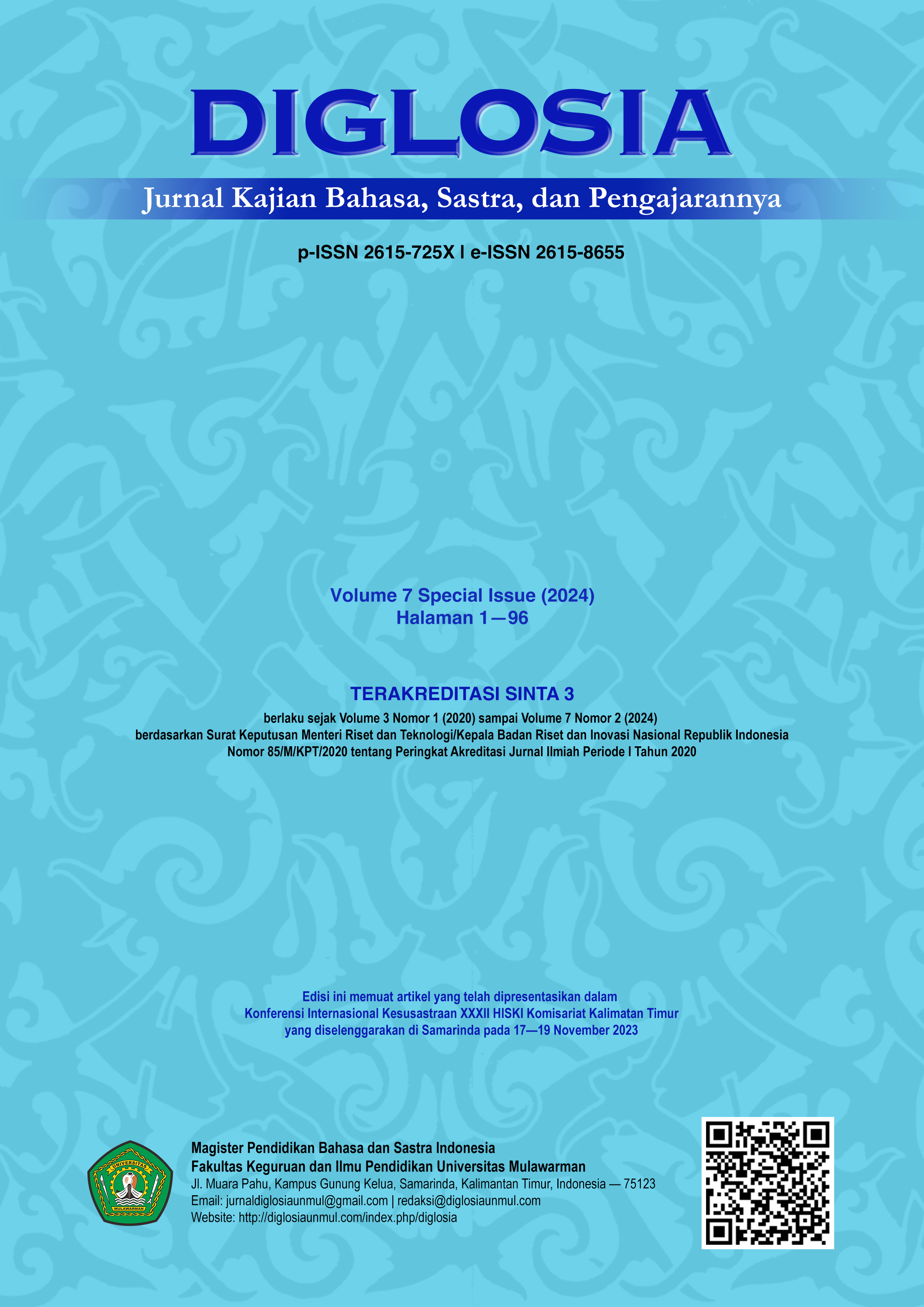Mitos masyarakat terhadap ritual di Candi Songgoriti sebagai warisan pengetahuan budaya lokal Community myths about rituals at Songgoriti Temple as a heritage of local cultural knowledge
Main Article Content
Abstract
This research aims to reveal the community's treatment of the Songgoriti temple and the grave of its founder, the rituals carried out at the Songgoriti temple and the grave of Mbah Patok along with the offerings and their meaning. This type of research is field research, a descriptive method with a qualitative approach. The research data consists of the behavior of people with beliefs and rituals at the Songgoriti temple and Mbah Patok's grave. Data sources were obtained from informants, events, and documents. Data collection techniques using observation, interviews, and document study. The collected data was analyzed using mythological theory. Every Legi Friday night at Soggoriti Temple and Mbah Patok's grave, 'sajen' and 'cok bakal' are offered and cleaned as a form of respect. The rituals carried out by the people in these two places include the ritual of asking for blessings, the ritual on the 1st of Sura, the village cleansing ritual, and the ritual of self-purification. Projection of the use of rituals for the younger generation as knowledge of local wisdom inherited from ancestors, as social learning and transmission of social heritage from one generation to the next, and inheritance of morals and ethics.
Downloads
Article Details
![]()
Every work in Diglosia: Jurnal Kajian Bahasa, Sastra, dan Pengajarannya is licensed under a Creative Commons Attribution-ShareAlike 4.0 International License.
Under the following terms:
- Attribution — You must give appropriate credit , provide a link to the license, and indicate if changes were made . You may do so in any reasonable manner, but not in any way that suggests the licensor endorses you or your use.
- ShareAlike — If you remix, transform, or build upon the material, you must distribute your contributions under the same license as the original.
- No additional restrictions — You may not apply legal terms or technological measures that legally restrict others from doing anything the license permits.
Authors who publish with this journal agree to the following terms:
- Authors retain copyright and grant the journal right of first publication with the work simultaneously licensed under a CC BY-SA 4.0 DEED Attribution-ShareAlike 4.0 Internationalthat allows others to share the work with an acknowledgment of the work's authorship and initial publication in this journal.
- Authors are able to enter into separate, additional contractual arrangements for the non-exclusive distribution of the journal's published version of the work (e.g., post it to an institutional repository or publish it in a book), with an acknowledgment of its initial publication in this journal.
- Authors are permitted and encouraged to post their work online (e.g., in institutional repositories or on their website) prior to and during the submission process, as it can lead to productive exchanges, as well as earlier and greater citation of published work.
References
Fetterman, D. M. (2010). Ethnography. Sage Publication.
Hakiki, L. 2022. Nilai-Nilai Multikulturalisme dalam Tradisi Ruwat Desa di Desa Pronojiwo Kecamatan Pronojiwo Kabupaten Lumajang. Jurnal Adat dan Budaya, 4(1). https://ejournal.undiksha.ac.id/index.php/JABI/article/view/42339
Hidayat, M., & Aini, W. (2020). Menggagas Kurikulum Pendidikan Inklusif-Multikultural: Opsi Legal Pembelajaran Berbasis Kearifan Lokal pada Pendidikan Anak Usia Dini (PAUD/RA). Tazkirah, 5(1), 272–289. https://e-journal.iai-al-azhaar.ac.id/index.php/tazkiroh/article/view/345
Hutasoit, R., Lattu, I. M., & Ebenhaizer, I.N.T. (2020). Kekuatan Simbolik Beras dalam Ritus Kehidupan Masyarakat Batak Toba. Anthropos: Jurnal Antropologi Sosial dan Budaya, 5(2), 183–195. http://dx.doi.org/10.24114/antro.v5i2.14922
Kartikasari, E. (2021). Nilai Budaya dalam Serat Ajisaka. Diglosia: Jurnal Kajian Bahasa, Sastra, Dan Pengajarannya, 4(2), 177–188. https://doi.org/10.30872/diglosia.v4i2.139
Miles, B. M., & Huberman, M. (1992). Analisis Data Kualitatif Buku Sumber Tentang Metode-metode Baru. UIP.
Pasaribu, A. Y., & Isnan, M. (2023). Analisis Teks Cerita Ulang pada Buku Bahasa Indonesia Kelas XI: Kajian Struktur Sastra dan Nilai-Nilai Karakter. Bahterasia: Jurnal Ilmiah Pendidikan Bahasa dan Sastra Indonesia, 4(2), 48–65. https://jurnal.umsu.ac.id/index.php/BAHTERASIA/article/view/16247
Rahmawati, I. S. (2018). Cerita Rakyat Nyi Rambut Kasih Sebagai Wujud Kearifan Lokal terhadap Pendidikan Sastra di Majalengka. Diglosia: Jurnal Pendidikan, Kebahasaan, dan Kesusastraan, 2(1), 50–56. https://jurnal.unma.ac.id/index.php/dl/article/view/1526
Rajja, R., Arifin, M. B., & Mursalim, M. (2020). Pengembangan Bahan Ajar Menulis Teks Cerpen dengan Metode Cerpen-gram untuk Siswa Kelas IX di Kecamatan Muara Wahau. Diglosia: Jurnal Kajian Bahasa, Sastra, Dan Pengajarannya, 3(1), 24–32. https://doi.org/10.30872/diglosia.v3i1.26
Simuh. (2003). Islam dan Pergumulan Budaya Jawa. Teraju.
Sulistyorini, D. (2020). Kosmologi danyang Telaga Rambut Monte dalam bersih desa di Desa Krisik Kecamatan Wlingi Kabupaten Blitar Jawa Timur. Prosiding Seminar Nasional Bahasa dan Sastra Indonesia (SENASBASA).
Turner, V. (1969). The Ritual Process: Structure and Anti-Structure. Cornel University Press.
Tylor, E. B. (2001). Dekonstruksi Kebenaran, Kritik Tujuh Teori Tentang Agama. Al Kalam.

